Lexus GX460 2010 Owner's Manual
Manufacturer: LEXUS, Model Year: 2010, Model line: GX460, Model: Lexus GX460 2010Pages: 830, PDF Size: 17.01 MB
Page 341 of 830
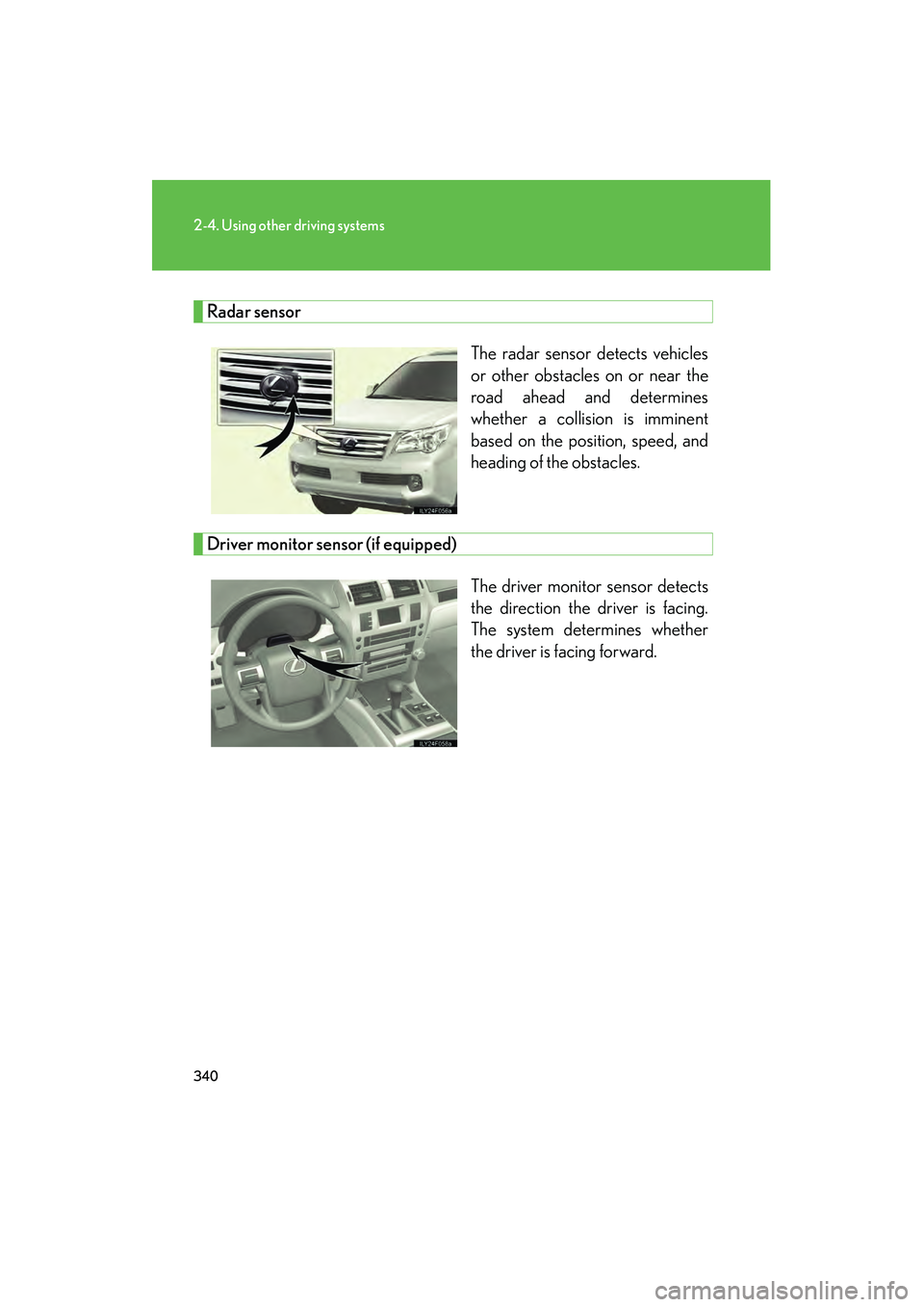
340
2-4. Using other driving systems
GX460_CANADA (OM60F29U)
Radar sensorThe radar sensor detects vehicles
or other obstacles on or near the
road ahead and determines
whether a collision is imminent
based on the position, speed, and
heading of the obstacles.
Driver monitor sensor (if equipped)
The driver monitor sensor detects
the direction the driver is facing.
The system determines whether
the driver is facing forward.
GX460_CANADA.book Page 340 Thursday, February 4, 2010 11:54 AM
Page 342 of 830
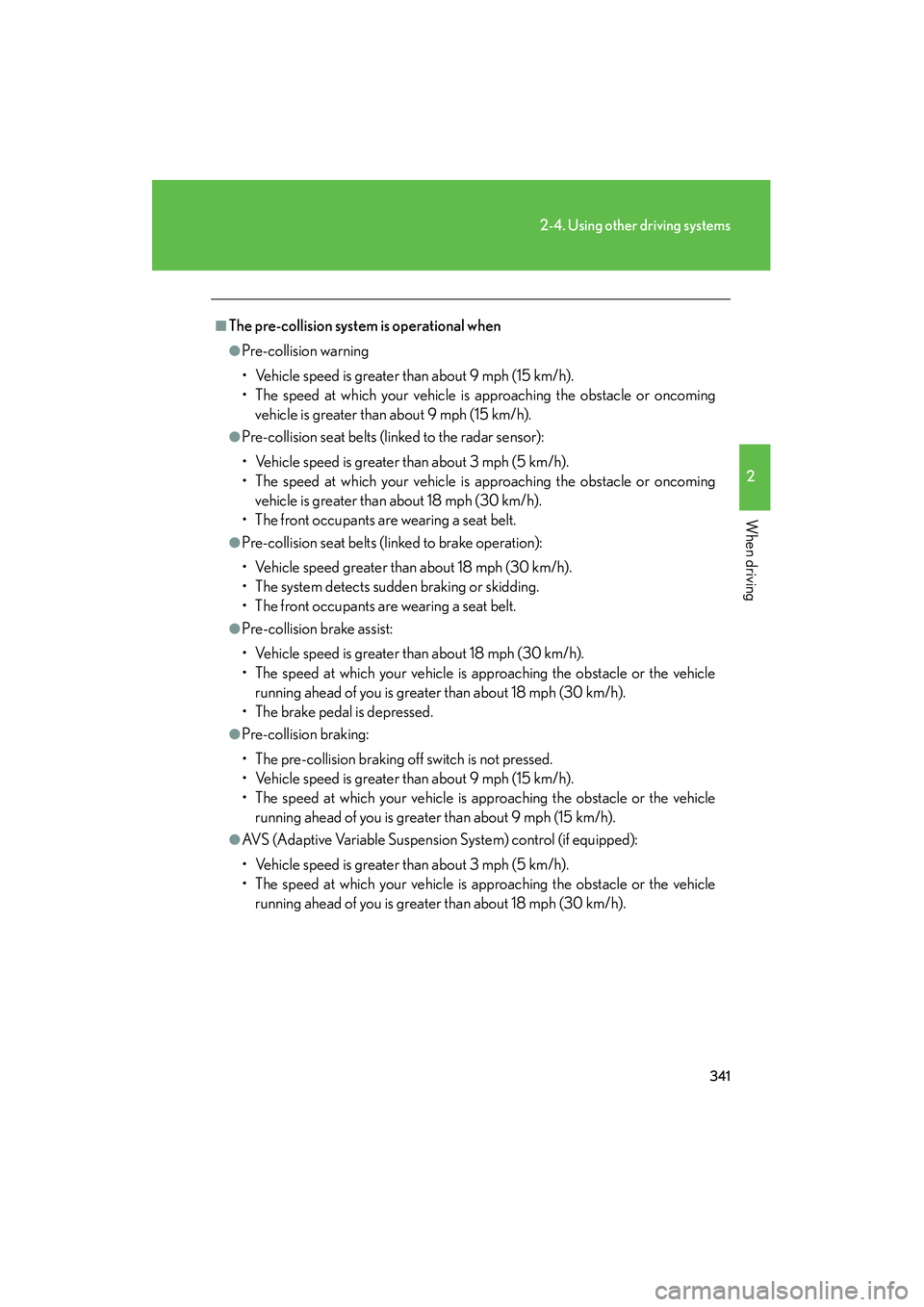
341
2-4. Using other driving systems
2
When driving
GX460_CANADA (OM60F29U)
■The pre-collision system is operational when
●Pre-collision warning
• Vehicle speed is greater than about 9 mph (15 km/h).
• The speed at which your vehicle is approaching the obstacle or oncomingvehicle is greater than about 9 mph (15 km/h).
●Pre-collision seat belts (linked to the radar sensor):
• Vehicle speed is greater than about 3 mph (5 km/h).
• The speed at which your vehicle is approaching the obstacle or oncoming
vehicle is greater than about 18 mph (30 km/h).
• The front occupants are wearing a seat belt.
●Pre-collision seat belts (linked to brake operation):
• Vehicle speed greater than about 18 mph (30 km/h).
• The system detects sudden braking or skidding.
• The front occupants are wearing a seat belt.
●Pre-collision brake assist:
• Vehicle speed is greater than about 18 mph (30 km/h).
• The speed at which your vehicle is approaching the obstacle or the vehicle running ahead of you is greater than about 18 mph (30 km/h).
• The brake pedal is depressed.
●Pre-collision braking:
• The pre-collision braking off switch is not pressed.
• Vehicle speed is greater than about 9 mph (15 km/h).
• The speed at which your vehicle is approaching the obstacle or the vehicle
running ahead of you is greater than about 9 mph (15 km/h).
●AVS (Adaptive Variable Suspension System) control (if equipped):
• Vehicle speed is greater than about 3 mph (5 km/h).
• The speed at which your vehicle is approaching the obstacle or the vehiclerunning ahead of you is greater than about 18 mph (30 km/h).
GX460_CANADA.book Page 341 Thursday, February 4, 2010 11:54 AM
Page 343 of 830
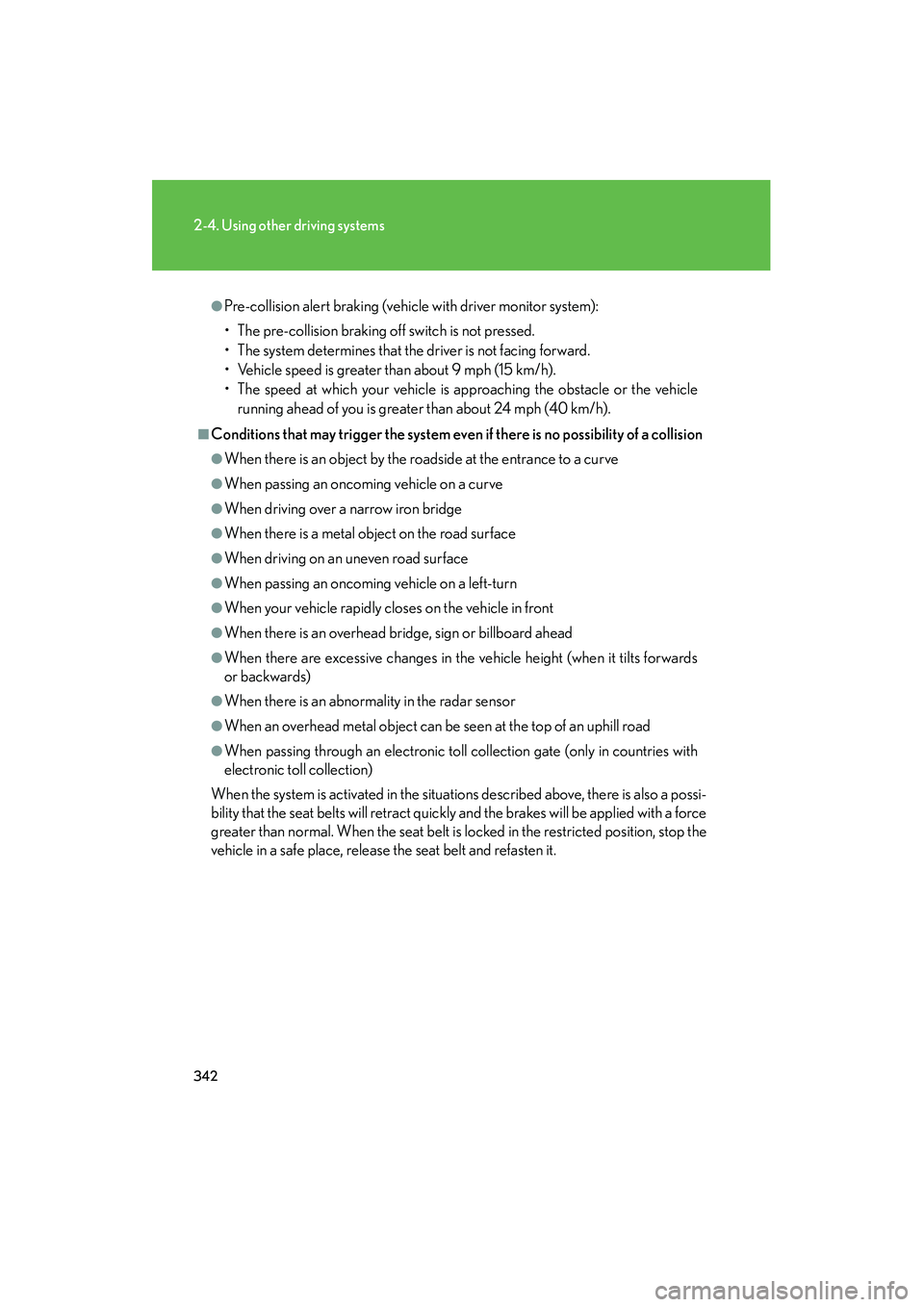
342
2-4. Using other driving systems
GX460_CANADA (OM60F29U)
●Pre-collision alert braking (vehicle with driver monitor system):
• The pre-collision braking off switch is not pressed.
• The system determines that the driver is not facing forward.
• Vehicle speed is greater than about 9 mph (15 km/h).
• The speed at which your vehicle is approaching the obstacle or the vehiclerunning ahead of you is greater than about 24 mph (40 km/h).
■Conditions that may trigger the system even if there is no possibility of a collision
●When there is an object by the roadside at the entrance to a curve
●When passing an oncoming vehicle on a curve
●When driving over a narrow iron bridge
●When there is a metal object on the road surface
●When driving on an uneven road surface
●When passing an oncoming vehicle on a left-turn
●When your vehicle rapidly closes on the vehicle in front
●When there is an overhead bridge, sign or billboard ahead
●When there are excessive changes in the vehicle height (when it tilts forwards
or backwards)
●When there is an abnormality in the radar sensor
●When an overhead metal object can be seen at the top of an uphill road
●When passing through an electronic toll collection gate (only in countries with
electronic toll collection)
When the system is activated in the situations described above, there is also a possi-
bility that the seat belts will retract quickly and the brakes will be applied with a force
greater than normal. When the seat belt is locked in the restricted position, stop the
vehicle in a safe place, release the seat belt and refasten it.
GX460_CANADA.book Page 342 Thursday, February 4, 2010 11:54 AM
Page 344 of 830
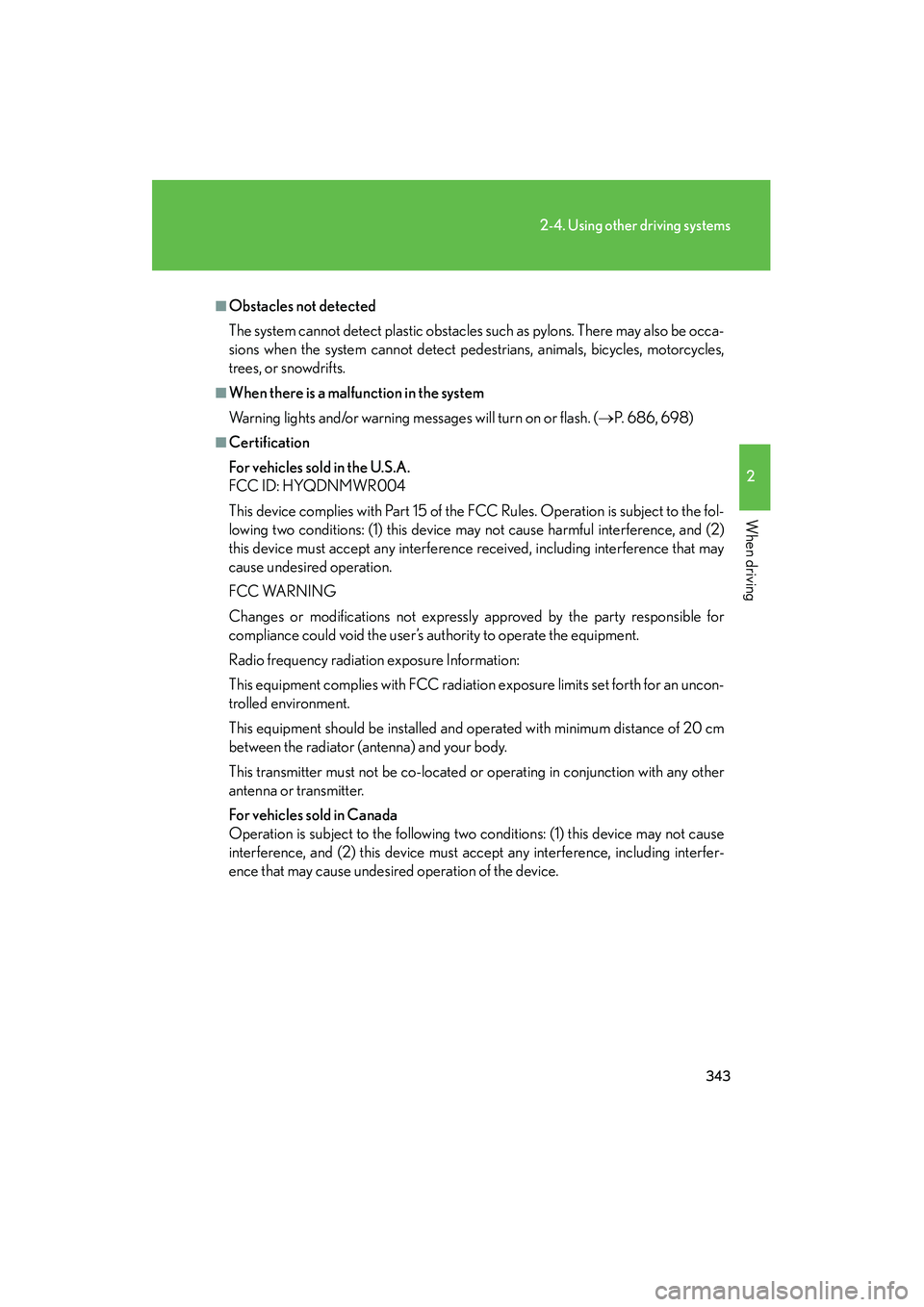
343
2-4. Using other driving systems
2
When driving
GX460_CANADA (OM60F29U)
■Obstacles not detected
The system cannot detect plastic obstacles such as pylons. There may also be occa-
sions when the system cannot detect pedestrians, animals, bicycles, motorcycles,
trees, or snowdrifts.
■When there is a malfunction in the system
Warning lights and/or warning messages will turn on or flash. (→P. 6 8 6 , 6 9 8 )
■Certification
For vehicles sold in the U.S.A.
FCC ID: HYQDNMWR004
This device complies with Part 15 of the FCC Rules. Operation is subject to the fol-
lowing two conditions: (1) this device may not cause harmful interference, and (2)
this device must accept any interference received, including interference that may
cause undesired operation.
FCC WARNING
Changes or modifications not expressly approved by the party responsible for
compliance could void the user’s authority to operate the equipment.
Radio frequency radiation exposure Information:
This equipment complies with FCC radiatio n exposure limits set forth for an uncon-
trolled environment.
This equipment should be installed and operated with minimum distance of 20 cm
between the radiator (antenna) and your body.
This transmitter must not be co-located or operating in conjunction with any other
antenna or transmitter.
For vehicles sold in Canada
Operation is subject to the following two conditions: (1) this device may not cause
interference, and (2) this device must accept any interference, including interfer-
ence that may cause undesired operation of the device.
GX460_CANADA.book Page 343 Thursday, February 4, 2010 11:54 AM
Page 345 of 830
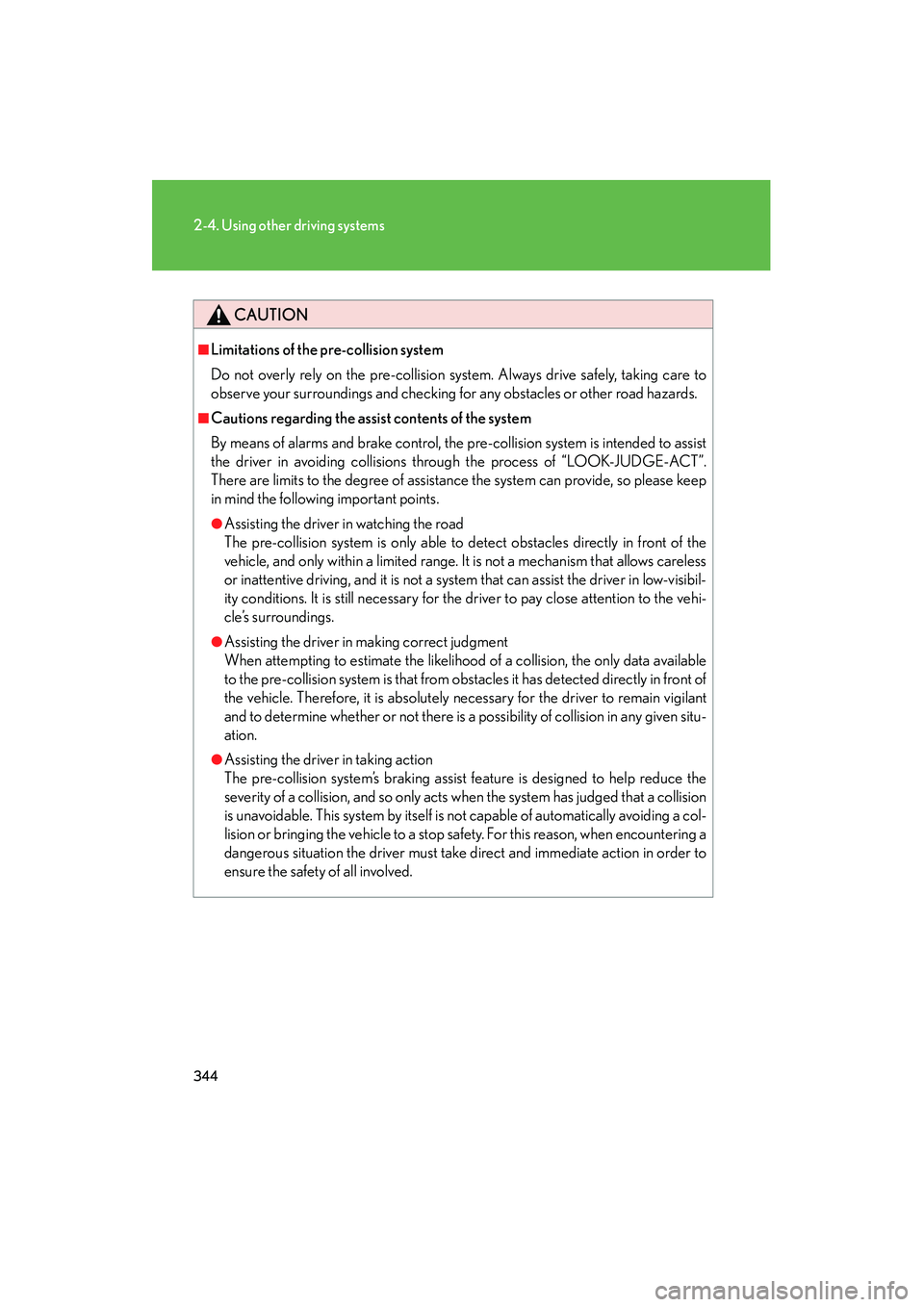
344
2-4. Using other driving systems
GX460_CANADA (OM60F29U)
CAUTION
■Limitations of the pre-collision system
Do not overly rely on the pre-collision system. Always drive safely, taking care to
observe your surroundings and checking for any obstacles or other road hazards.
■Cautions regarding the assist contents of the system
By means of alarms and brake control, the pre-collision system is intended to assist
the driver in avoiding collisions through the process of “LOOK-JUDGE-ACT”.
There are limits to the degree of assistance the system can provide, so please keep
in mind the following important points.
●Assisting the driver in watching the road
The pre-collision system is only able to detect obstacles directly in front of the
vehicle, and only within a limited range. It is not a mechanism that allows careless
or inattentive driving, and it is not a system that can assist the driver in low-visibil-
ity conditions. It is still necessary for the driver to pay close attention to the vehi-
cle’s surroundings.
●Assisting the driver in making correct judgment
When attempting to estimate the likelihood of a collision, the only data available
to the pre-collision system is that from obstacles it has detected directly in front of
the vehicle. Therefore, it is absolutely necessary for the driver to remain vigilant
and to determine whether or not there is a possibility of collision in any given situ-
ation.
●Assisting the driver in taking action
The pre-collision system’s braking assist feature is designed to help reduce the
severity of a collision, and so only acts when the system has judged that a collision
is unavoidable. This system by itself is not capable of automatically avoiding a col-
lision or bringing the vehicle to a stop safety. For this reason, when encountering a
dangerous situation the driver must take direct and immediate action in order to
ensure the safety of all involved.
GX460_CANADA.book Page 344 Thursday, February 4, 2010 11:54 AM
Page 346 of 830
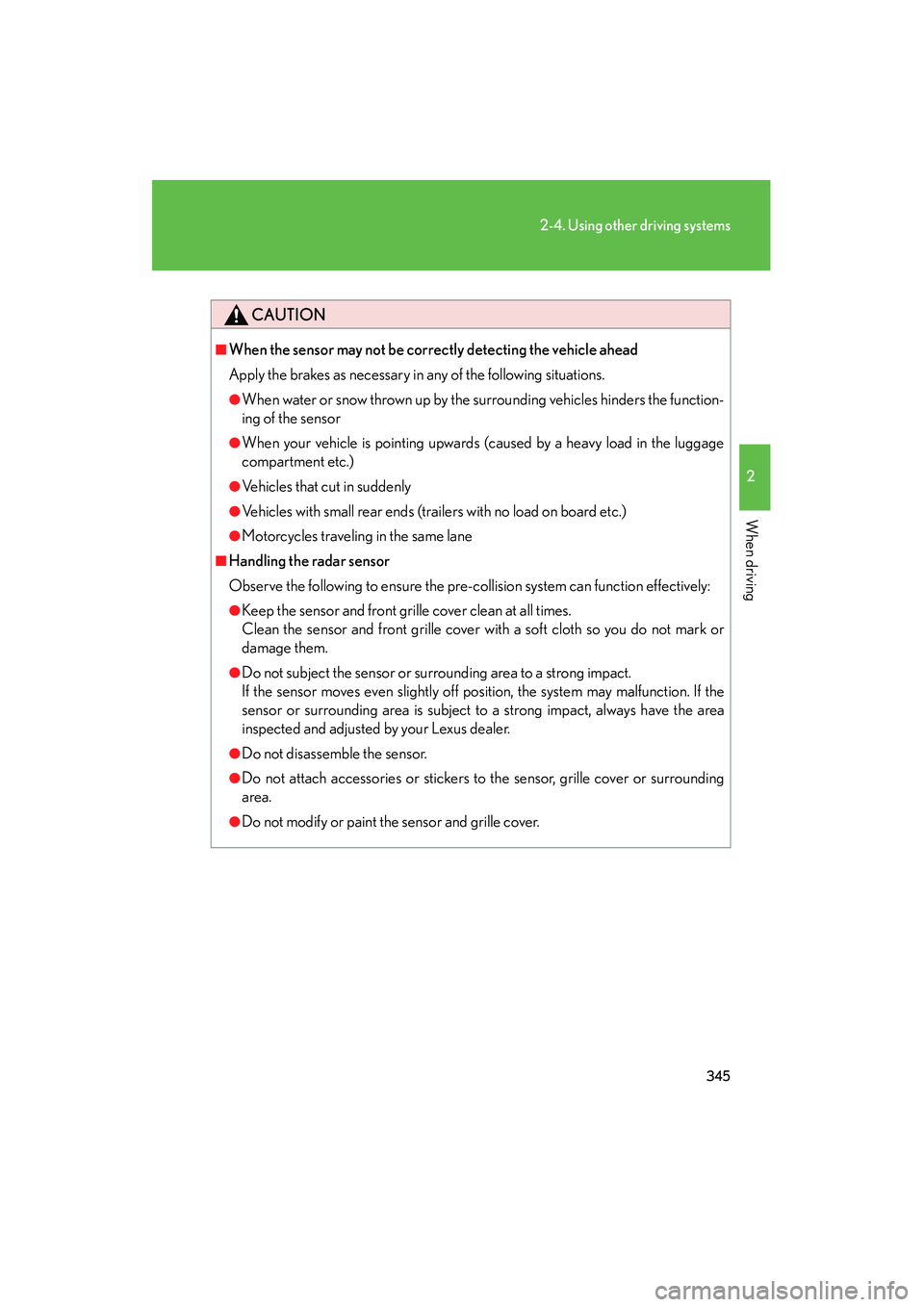
345
2-4. Using other driving systems
2
When driving
GX460_CANADA (OM60F29U)
CAUTION
■When the sensor may not be correctly detecting the vehicle ahead
Apply the brakes as necessary in any of the following situations.
●When water or snow thrown up by the surrounding vehicles hinders the function-
ing of the sensor
●When your vehicle is pointing upwards (caused by a heavy load in the luggage
compartment etc.)
●Vehicles that cut in suddenly
●Vehicles with small rear ends (trailers with no load on board etc.)
●Motorcycles traveling in the same lane
■Handling the radar sensor
Observe the following to ensure the pre-collision system can function effectively:
●Keep the sensor and front grille cover clean at all times.
Clean the sensor and front grille cover with a soft cloth so you do not mark or
damage them.
●Do not subject the sensor or surrounding area to a strong impact.
If the sensor moves even slightly off position, the system may malfunction. If the
sensor or surrounding area is subject to a strong impact, always have the area
inspected and adjusted by your Lexus dealer.
●Do not disassemble the sensor.
●Do not attach accessories or stickers to the sensor, grille cover or surrounding
area.
●Do not modify or paint the sensor and grille cover.
GX460_CANADA.book Page 345 Thursday, February 4, 2010 11:54 AM
Page 347 of 830

346
2-4. Using other driving systems
GX460_CANADA (OM60F29U)
CAUTION
■Handling the driver monitor sensor (vehicles with driver monitor sensor)
Observe the following to ensure the driver monitor sensor can function effectively.
Failure to do so may result in a malfun ction or may prevent the system from cor-
rectly determining the direction the driver is facing, resulting in an unexpected acci-
dent.
●Do not disassemble, damage, lift or pull on the sensor.
●Do not touch the sensor while driving.
●Do not wet or spill water on the sensor.
●Do not drop anything on or allow anything to hit against the sensor. Do not sub-
ject the sensor to an impact.
●Make sure that there are no scratches, dirt or stickers on the side of the sensor
that faces the driver.
●Do not place any objects in front of the side of the sensor that faces the driver or
cover the sensor.
■Determining the direction the driver is facing (vehicles with driver monitor sen-
sor)
The direction the driver is facing may not be determined correctly if the following
conditions exist:
●There is an object between the driver monitor sensor and the driver’s face, such
as when the sensor is blocked.
●A part of the driver’s face is covered.
●The sensor or the driver’s face is exposed to intense light such as sunlight.
●The driving posture is improper.
GX460_CANADA.book Page 346 Thursday, February 4, 2010 11:54 AM
Page 348 of 830
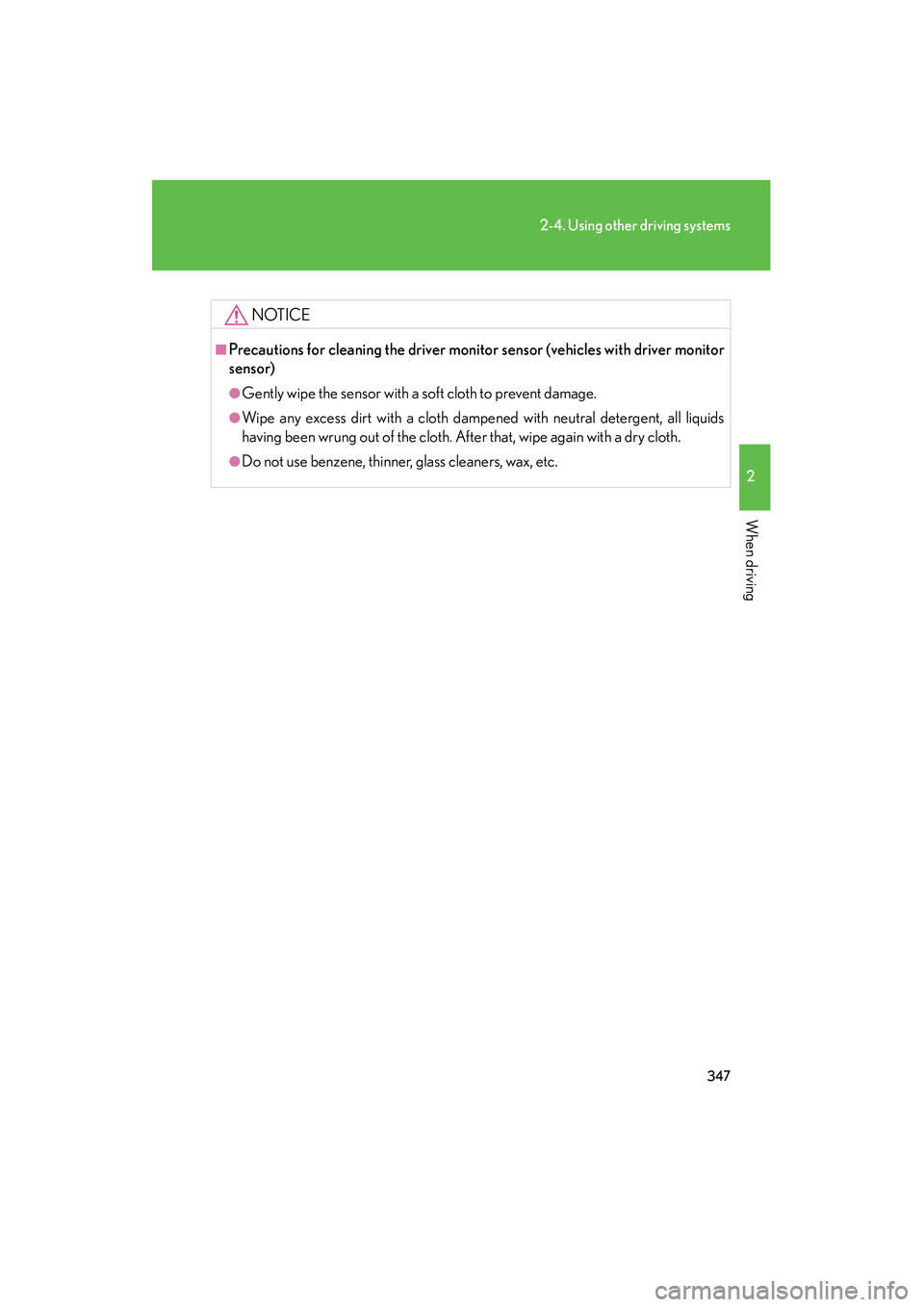
347
2-4. Using other driving systems
2
When driving
GX460_CANADA (OM60F29U)
NOTICE
■Precautions for cleaning the driver monitor sensor (vehicles with driver monitor
sensor)
●Gently wipe the sensor with a soft cloth to prevent damage.
●Wipe any excess dirt with a cloth dampened with neutral detergent, all liquids
having been wrung out of the cloth. After that, wipe again with a dry cloth.
●Do not use benzene, thinner, glass cleaners, wax, etc.
GX460_CANADA.book Page 347 Thursday, February 4, 2010 11:54 AM
Page 349 of 830
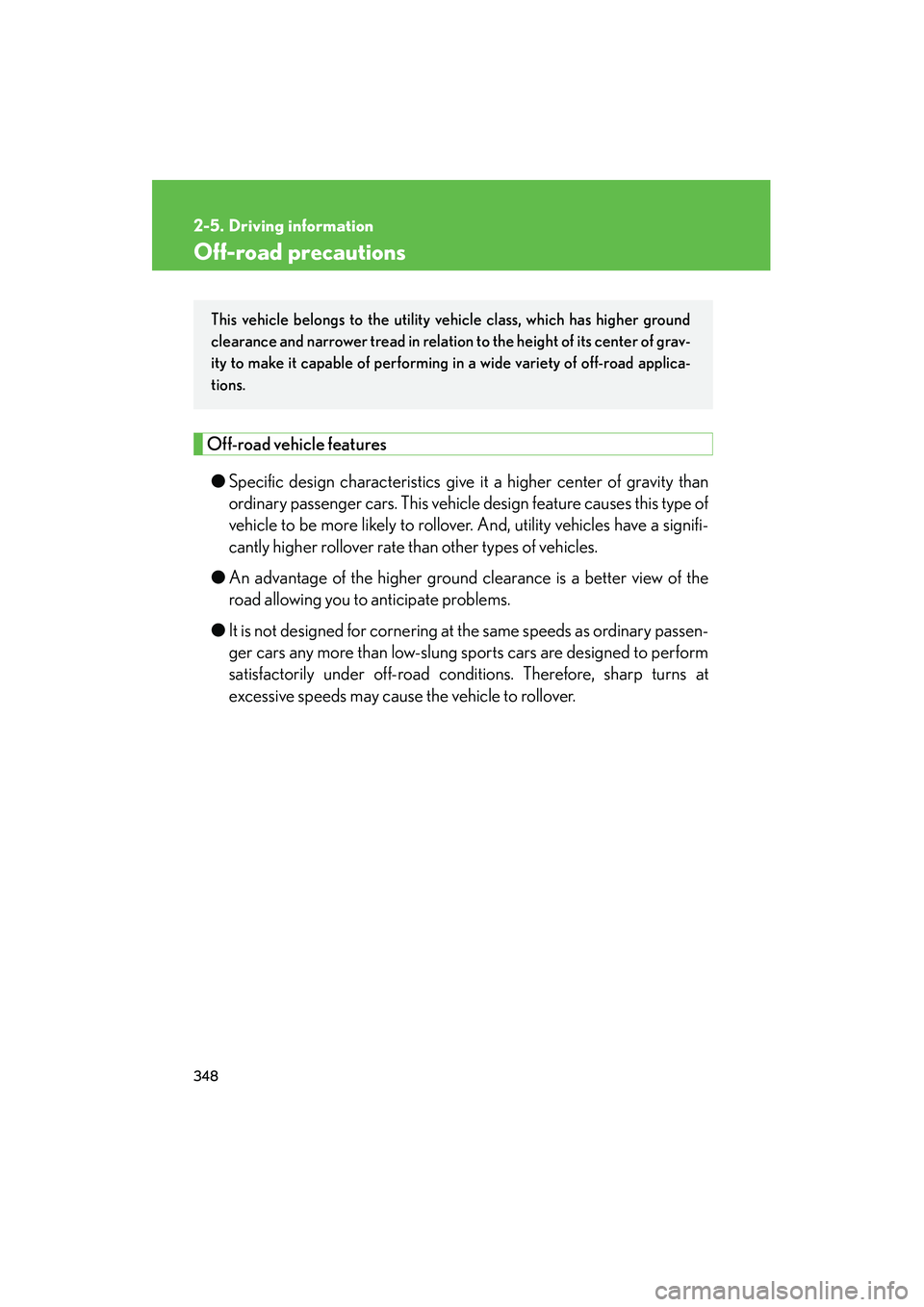
348
GX460_CANADA (OM60F29U)
2-5. Driving information
Off-road precautions
Off-road vehicle features● Specific design characteristics give it a higher center of gravity than
ordinary passenger cars. This vehicle design feature causes this type of
vehicle to be more likely to rollover. And, utility vehicles have a signifi-
cantly higher rollover rate than other types of vehicles.
● An advantage of the higher ground clearance is a better view of the
road allowing you to anticipate problems.
● It is not designed for cornering at the same speeds as ordinary passen-
ger cars any more than low-slung sports cars are designed to perform
satisfactorily under off-road conditions. Therefore, sharp turns at
excessive speeds may cause the vehicle to rollover.
This vehicle belongs to the utility vehicle class, which has higher ground
clearance and narrower tread in relation to the height of its center of grav-
ity to make it capable of performing in a wide variety of off-road applica-
tions.
GX460_CANADA.book Page 348 Thursday, February 4, 2010 11:54 AM
Page 350 of 830
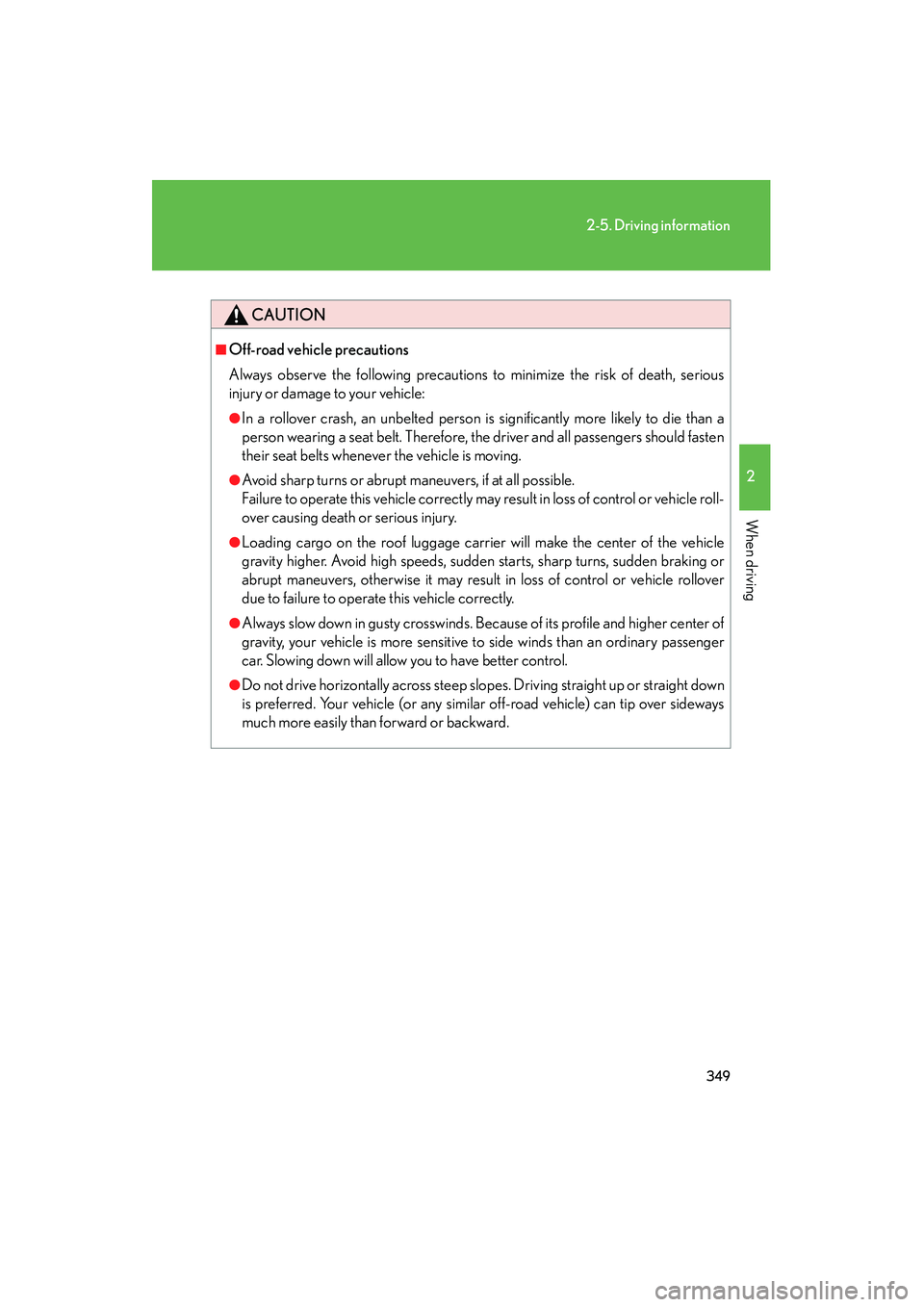
349
2-5. Driving information
2
When driving
GX460_CANADA (OM60F29U)
CAUTION
■Off-road vehicle precautions
Always observe the following precautions to minimize the risk of death, serious
injury or damage to your vehicle:
●In a rollover crash, an unbelted person is significantly more likely to die than a
person wearing a seat belt. Therefore, the driver and all passengers should fasten
their seat belts whenever the vehicle is moving.
●Avoid sharp turns or abrupt maneuvers, if at all possible.
Failure to operate this vehicle correctly may result in loss of control or vehicle roll-
over causing death or serious injury.
●Loading cargo on the roof luggage carrier will make the center of the vehicle
gravity higher. Avoid high speeds, sudden starts, sharp turns, sudden braking or
abrupt maneuvers, otherwise it may result in loss of control or vehicle rollover
due to failure to operate this vehicle correctly.
●Always slow down in gusty crosswinds. Because of its profile and higher center of
gravity, your vehicle is more sensitive to side winds than an ordinary passenger
car. Slowing down will allow you to have better control.
●Do not drive horizontally across steep slopes. Driving straight up or straight down
is preferred. Your vehicle (or any similar off-road vehicle) can tip over sideways
much more easily than forward or backward.
GX460_CANADA.book Page 349 Thursday, February 4, 2010 11:54 AM